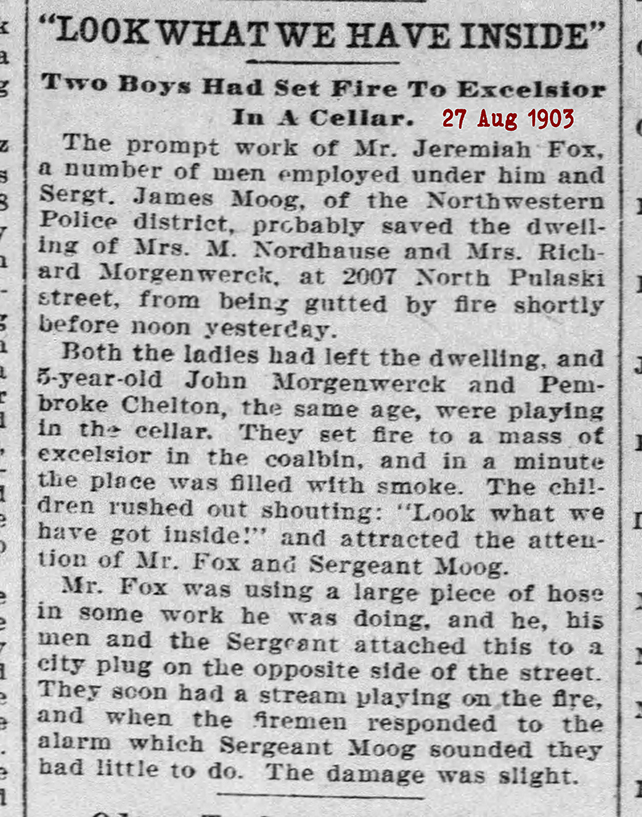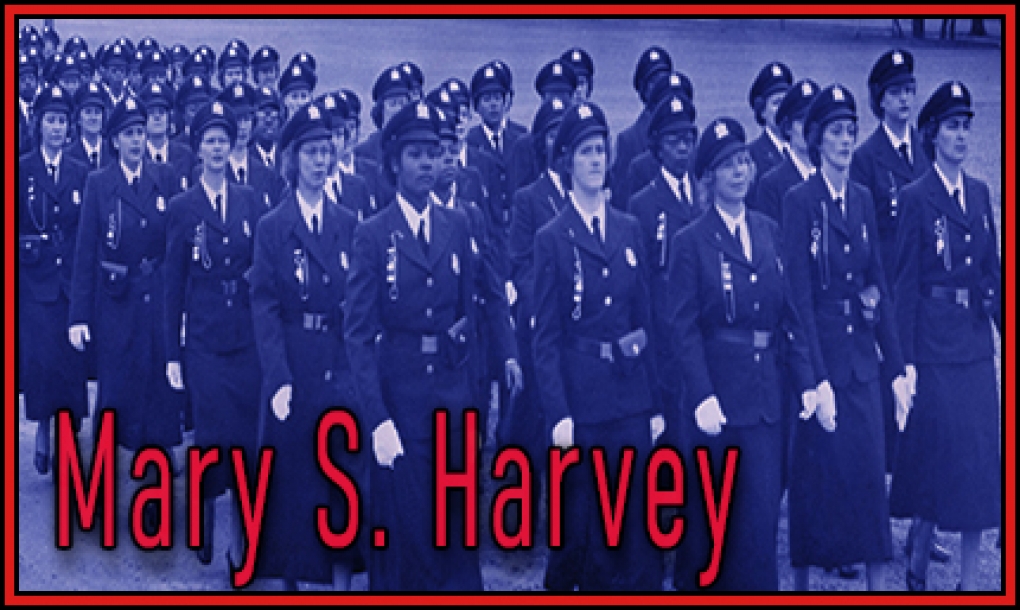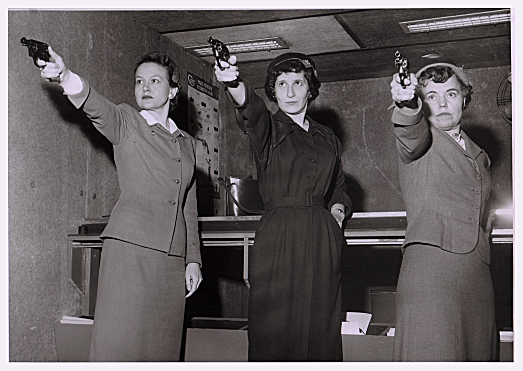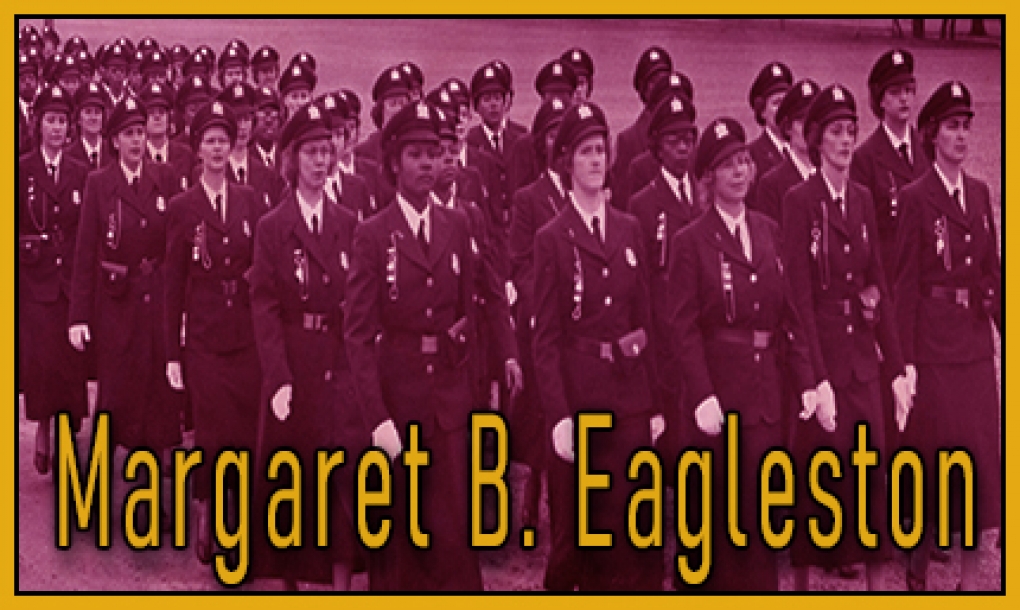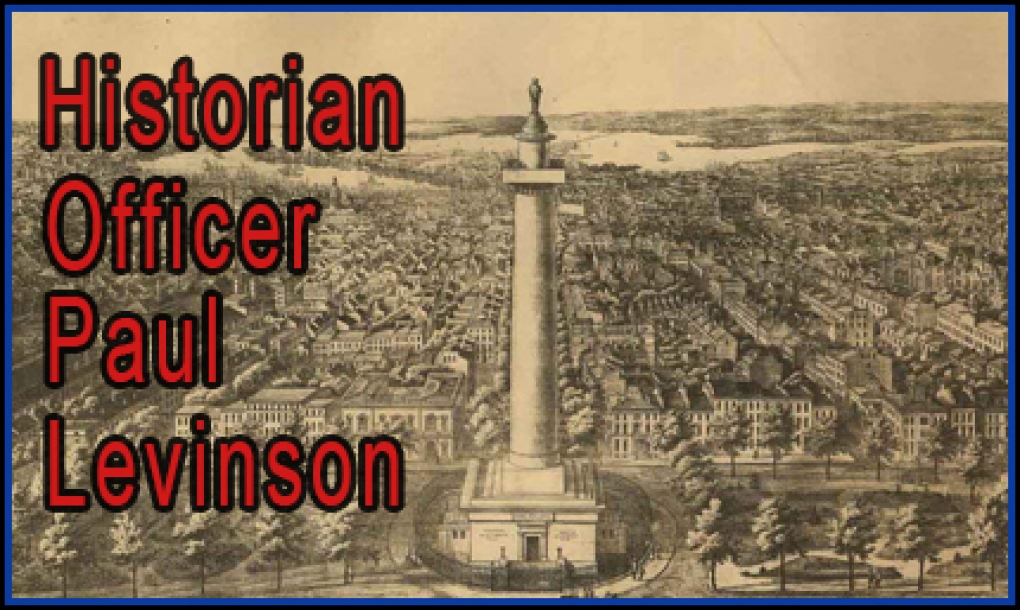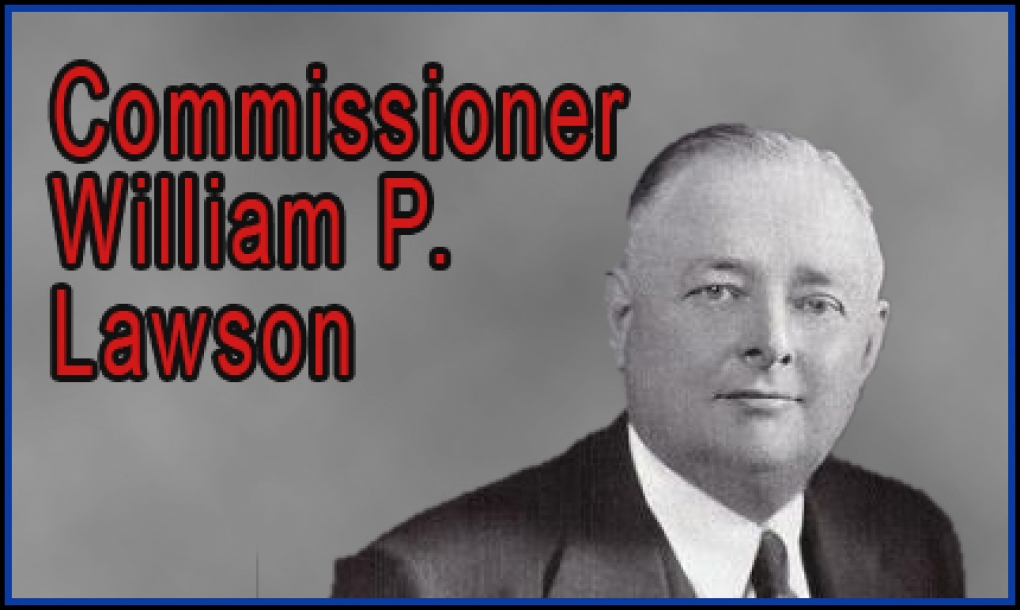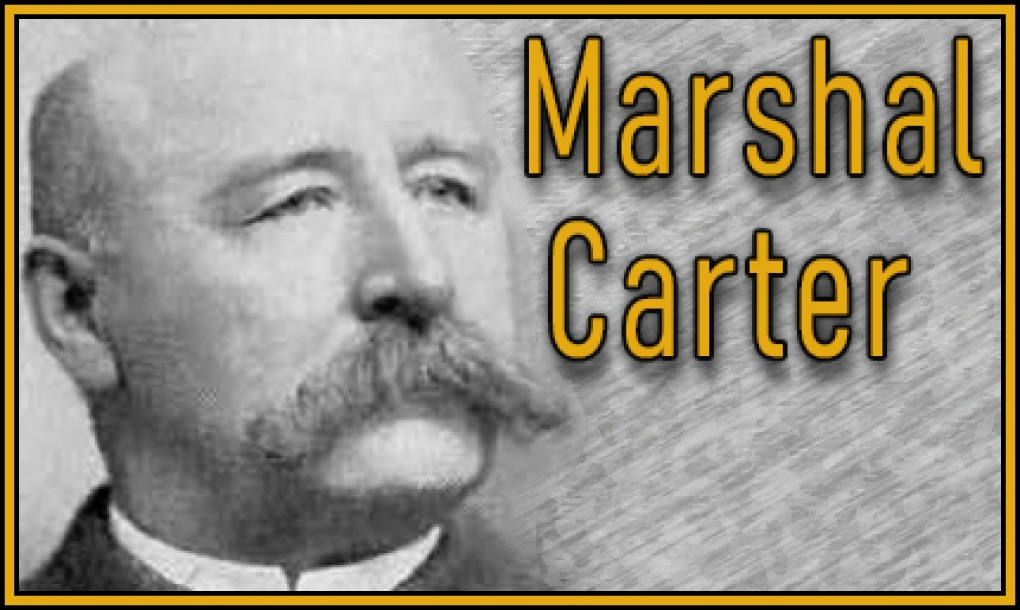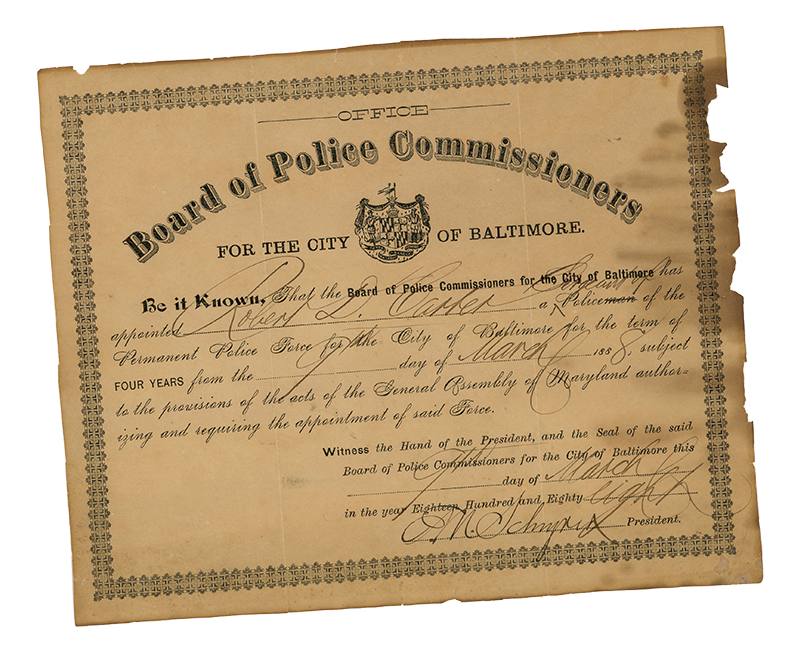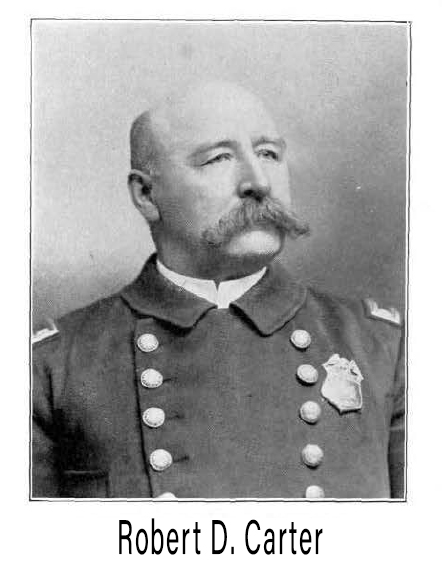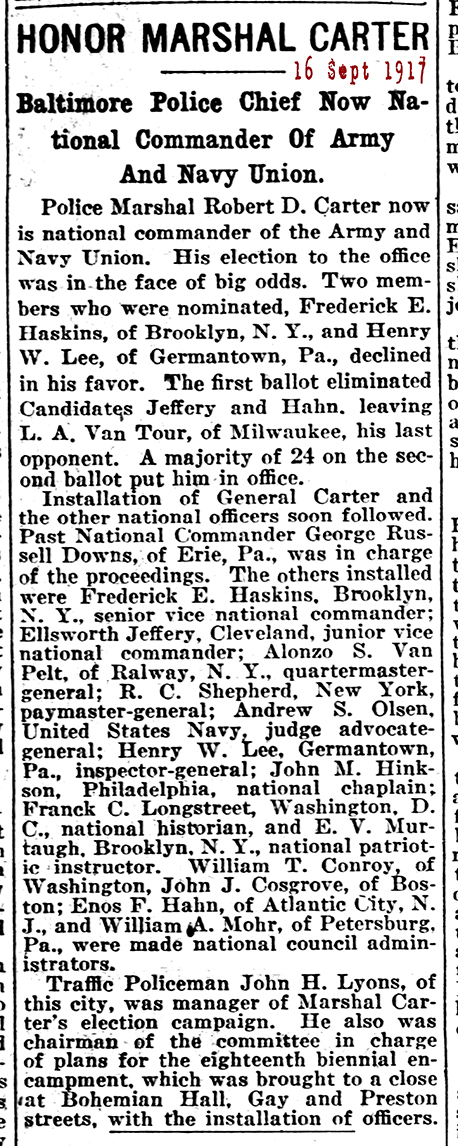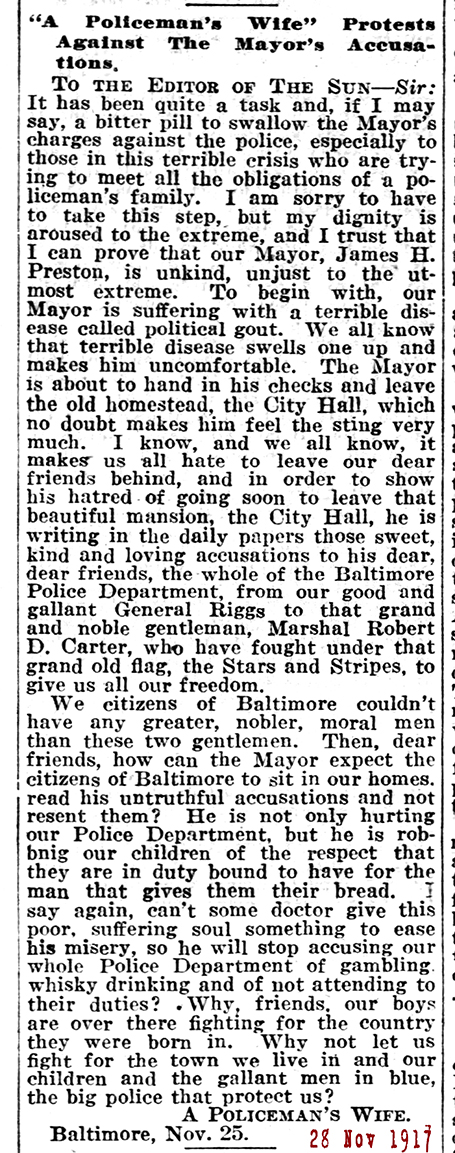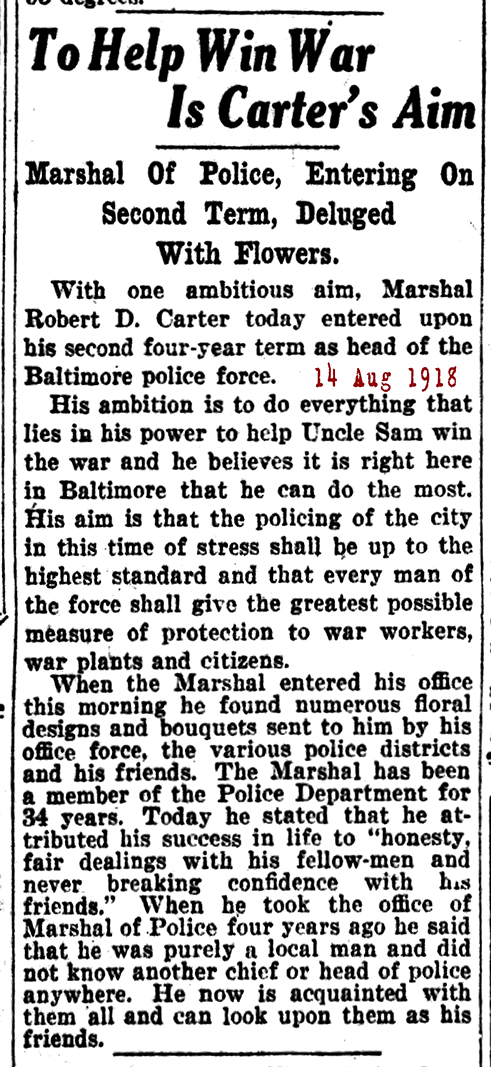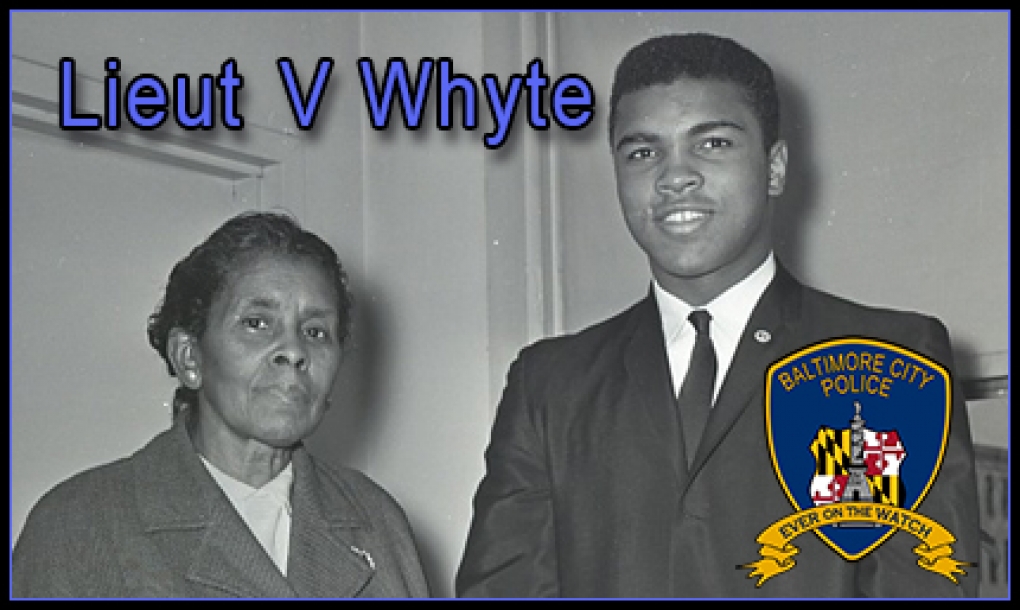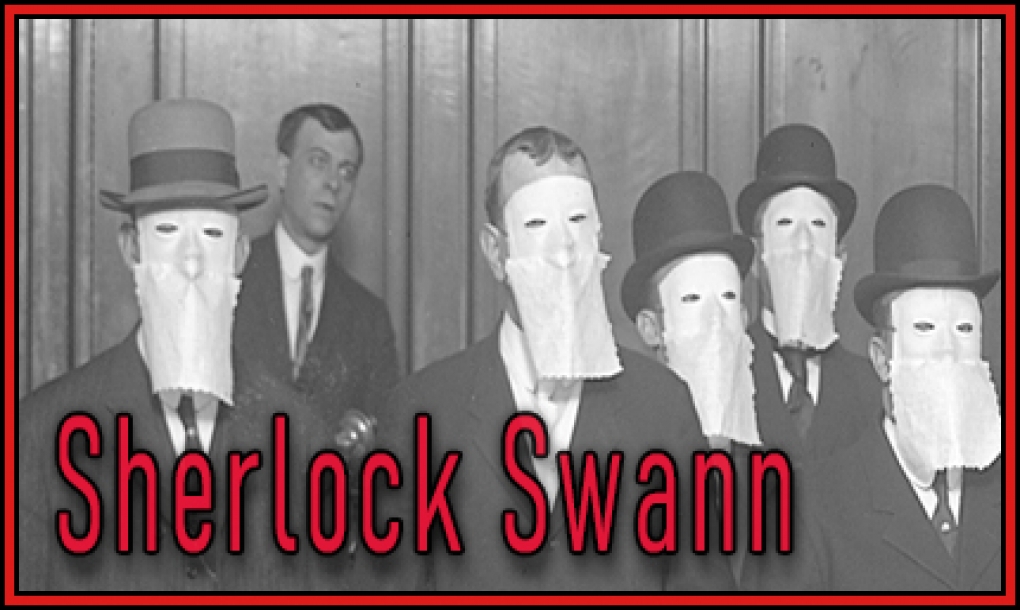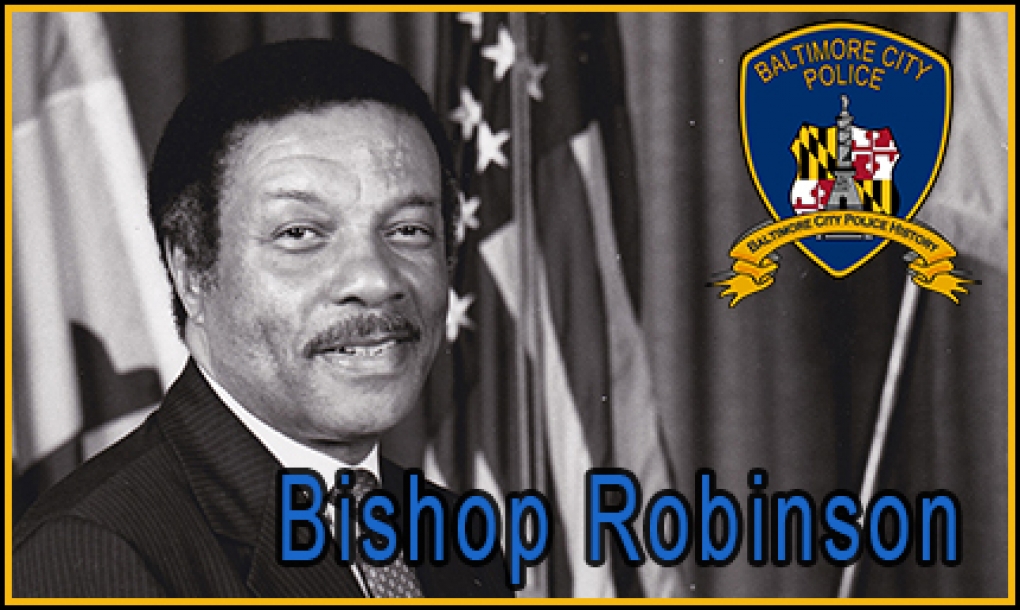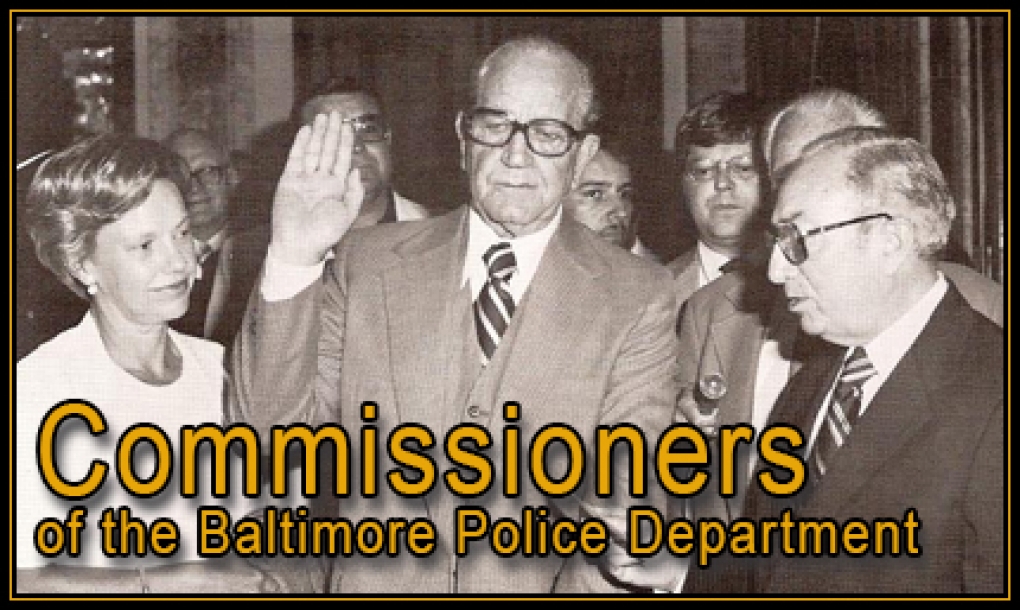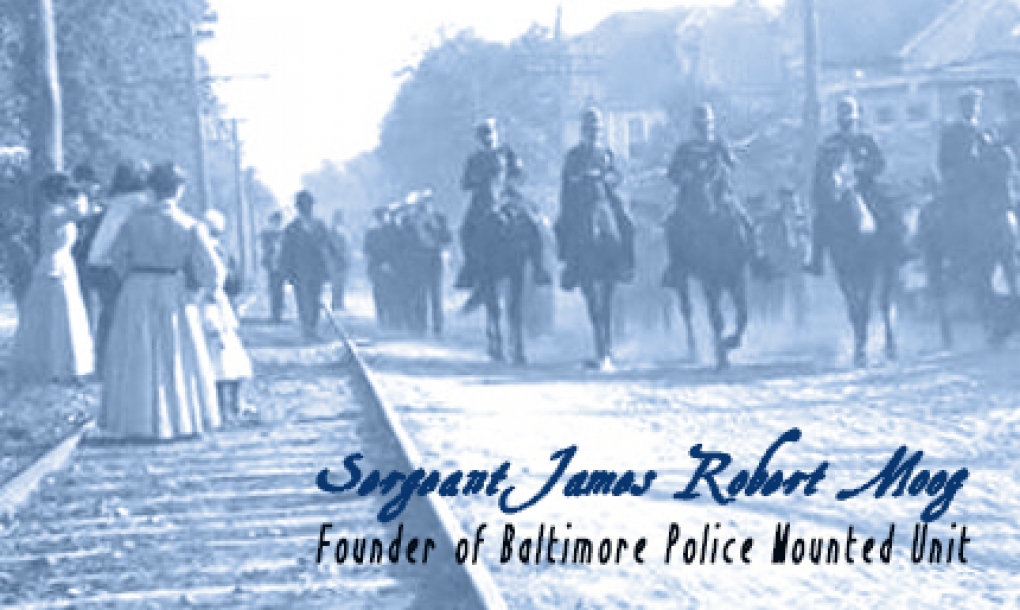

Sergeant James Robert Moog
28 February 1931
Sergeant Moog, City’s Oldest Officers, Dies
On Active Duty Until 10 Days Ago, He Was Policeman Nearly 50 Years
Sergeant James Robert Moog, the senior of all men in the Baltimore Police Department, a Morgan Cavalryman [**] during the Civil War, and founder of Baltimore Police Department's Mounted Police Unit circa 1888 died in Mercy Hospital late last night [27 February 1931] following an operation for appendicitis. In rare cases, a blunt trauma of the abdomen (BTA) can be a direct cause of appendicitis. Seeing as how this happened more than 85 years ago it would be hard to tell if this due to some kind of trauma at the stables, or from illness, all we know is it occurred while working and on a streetcar he began to suffer from what he thought was an attack of bronchial asthma but was later found to be or brought on a case of an acute appendicitis.
Note: Animals are a common trigger of asthma symptoms. One might be allergic to just one animal or more than one. Often, it's cats, dogs or horses. This means that even if the sergeant had a horse he was younger and did not react to it, he could be allergic to horses now. Sometimes, even if one has been around an animal for their entire life without developing allergies, it's possible to become allergic in their later years. There are also studies that show active asthma could be an unrecognized risk factor for appendicitis, it has been noted with children and the elderly. I don't know if this is a line of duty or not, but given the fact that he served 50 years, he fought in the civil war, and after losing a foot, that they took off while he was awake and watching. After having his foot removed, he got a prosthetic and continued to work. I think it would be great to continue to remember Sgt Moog, I mean what an inspiration to hear of the toughness and dedication of this kind of police.
The asthma to appendicitis study can be found HERE
If he had lived until April 11th of 1931 he would have completed 50 years in the police department, one of the very few men at the time to have accomplished that. Detective Lieutenant Thomas F. Login, died a year earlier, was one such a man. Sergeant Moog was 86 years old when he died.
Became Ill on a Streetcar
He was on active duty until 10 days prior to his death and was in charge of the stables for the Mounted Division on South Frederick Street. On the day he was stricken by an attack of bronchial asthma he was on a streetcar, he was taken from the streetcar on Eutaw Street and Druid Hill Avenue by an ambulance from the No. 7 Engine House to the hospital. There his asthma developed into an acute case of appendicitis.
A widower, Sergeant Moog lived with his daughter, Miss Catherine Moog, head of the department of English of the Eastern High School, at 3807 Bonner road
Funeral on Monday
The funeral services took place from his home that following Monday afternoon. His son was a member of the faculty of a Boston School of Music. He also had a second daughter, Mrs. Augustine Patterson, that also lived in Bolton.
Sergeant Moog’s service with the department began in early 1886 where he was assigned to work the Northwest District. He spent the greater part of half a century on horseback as a member of the Mounted Division patrolling it outlying sections, chiefly in the Northwest District. A love of horses was a marked characteristic of him throughout his life.
Always Wore Uniform
He always wore his uniform, with a yellow marking of the Cavalry Division. (In early BPD history, uniformed officers wore their uniforms both on and off duty) For years he led the police platoon which rode at the head of processions, from those to honor visiting celebrities to the military processions which marked the participation of this country in the world war and the return of the troops from France.
A real trooper, he knew the nature of the horse, he was at ease in the saddle no matter how great the blaring of the band’s behind him or nervousness of his mount.
Foot Is Amputated
At the battle of Gettysburg, a bullet struck him in the foot. Two years ago, (1929) after the passing of 60 some odd years, an infection developed in that foot and he was taken to Union Memorial Hospital. There it was found to be necessary to have the foot amputated.
A survivor of the civil war, when anesthesia was not as common as they were in 1931, the Sergeant told the surgeons that he did not need an anesthetic, and to go ahead and take his foot off; in fact, he wanted to see it, anyway. He was given a local anesthetic and the operation performed.
Since that time, he had not ridden a horse but remained in charge of the stables. He had an artificial foot made and his short, strong figure, of the Sergeant walking with a cane, continued to be seen about the police building as he appeared there to make his daily reports, but since he could no longer ride, he was forced to use streetcars to get around the city.
![]()
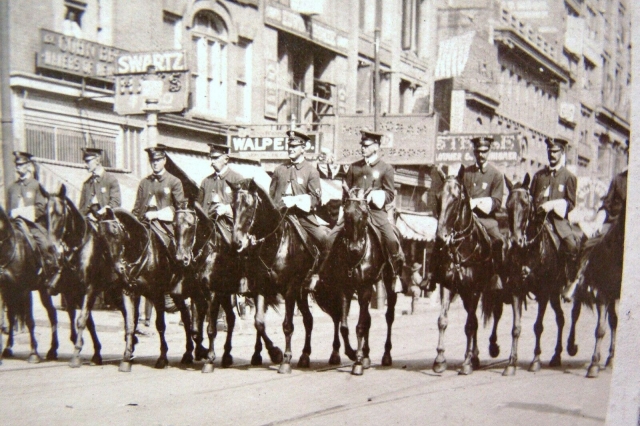 Possibly taken in 1912 during the democratic convention here in Baltimore
Possibly taken in 1912 during the democratic convention here in Baltimore
The rider second from the left appears to me Sgt James Moog
Morgan Cavalryman Refers to John Hunt Morgan
1 Jun 1825 - 4 Sep 1864
John Hunt Morgan (June 1, 1825 – September 4, 1864) was a Confederate general in the American Civil War. In April 1862, he raised the 2nd Kentucky Cavalry Regiment, fought at Shiloh, and then launched a costly raid in Kentucky, which encouraged Braxton Bragg's invasion of that state. He also attacked the supply-lines of General William Rosecrans. In July 1863, he set out on a 1,000-mile raid into Indiana and Ohio, taking hundreds of prisoners. But after most of his men had been intercepted by Union gunboats, Morgan surrendered at Salineville, Ohio, the northernmost point ever reached by uniformed Confederates. The legendary "Morgan's Raid", which had been carried out against orders, gained no tactical advantage for the Confederacy, while the loss of his regiment proved a serious setback. Morgan escaped from his Union prison but his credibility was low, and he was restricted to minor operations. He was killed at Greeneville, Tennessee, in September 1864. Morgan was the brother-in-law of Confederate general A. P. Hill.
Like most Kentuckians, Morgan did not initially support secession. Immediately after Lincoln's election in November 1860, he wrote to his brother, Thomas Hunt Morgan, then a student at Kenyon College in northern Ohio, "Our State will not I hope secede I have no doubt but Lincoln will make a good President, at least we ought to give him a fair trial & then if he commits some overt act all the South will be a unit." By the following spring, Tom Morgan (who also had opposed Kentucky's secession) had transferred home to the Kentucky Military Institute and there began to support the Confederacy. Just before the Fourth of July, by way of a steamer from Louisville, he quietly left for Camp Boone, just across the Tennessee border, to enlist in the Kentucky State Guard. John stayed at home in Lexington to tend to his troubled business and his ailing wife. Becky Morgan finally died on July 21, 1861.
In September, Captain Morgan and his militia company went to Tennessee and joined the Confederate States Army. Morgan soon raised the 2nd Kentucky Cavalry Regiment and became its colonel on April 4, 1862.
Morgan and his cavalrymen fought at the Battle of Shiloh in April 1862, and he soon became a symbol to secessionists in their hopes for obtaining Kentucky for the Confederacy. A Louisiana writer, Robert D. Patrick, compared Morgan to Francis Marion and wrote that "a few thousands of such men as his would regain us Kentucky and Tennessee."
In his first Kentucky raid, Morgan left Knoxville on July 4, 1862, with almost 900 men and in three weeks swept through Kentucky, deep in the rear of Major General Don Carlos Buell's army. He reported the capture of 1,200 Federal soldiers, whom he paroled, acquired several hundred horses, and destroyed massive quantities of supplies. He unnerved Kentucky's Union military government, and President Abraham Lincoln received so many frantic appeals for help that he complained that "they are having a stampede in Kentucky." Historian Kenneth W. Noe wrote that Morgan's feat "in many ways surpassed J. E. B. Stuart's celebrated 'Ride around McClellan' and the Army of the Potomac the previous spring." The success of Morgan's raid was one of the key reasons that the Confederate Heartland Offensive of Braxton Bragg and Edmund Kirby Smith was launched later that fall, assuming that tens of thousands of Kentuckians would enlist in the Confederate Army if they invaded the state.
As a colonel, he was presented with a Palmetto Armory pistol by the widow of Brigadier General Barnard Elliott Bee Jr. That pistol is now owned by the Museum of the American Civil War.
Morgan was promoted to brigadier general (his highest rank) on December 11, 1862, though the Promotion Orders were not signed by President Davis until December 14, 1862. He received the thanks of the Confederate Congress on May 1, 1863, for his raids on the supply lines of Union Major General William S. Rosecrans in December and January, most notably his victory at the Battle of Hartsville on December 7.
On December 14, 1862, Morgan married Martha "Mattie" Ready, the daughter of Tennessee United States Representative Charles Ready and a cousin of William T. Haskell, another former U.S. representative from Tennessee.
Morgan's Raid
Hoping to divert Union troops and resources in conjunction with the twin Confederate operations of Vicksburg and Gettysburg in the summer of 1863, Morgan set off on the campaign that would become known as "Morgan's Raid". Morgan crossed the Ohio River and raided across southern Indiana and Ohio. At Corydon, Indiana, the raiders met 450 local Home Guard in a battle that resulted in eleven Confederates killed and five Home Guard killed.
In July, at Versailles, IN, while soldiers raided nearby militia and looted county and city treasuries, the jewels of the local masonic lodge were stolen. When Morgan, a Freemason, learned of the theft he recovered the jewels and returned them to the lodge the following day.
After several more skirmishes, during which he captured and paroled thousands of Union soldiers[citation needed], Morgan's raid almost ended on July 19, 1863, at Buffington Island, Ohio, when approximately 700 of his men were captured while trying to cross the Ohio River into West Virginia. Intercepted by Union gunboats, less than 200 of his men succeeded in crossing. Most of Morgan's men captured that day spent the rest of the war in the infamous Camp Douglas Prisoner of War camp in Chicago, which had a very high death rate. On July 26, near Salineville, Ohio, Morgan and his exhausted, hungry and saddle-sore soldiers were finally forced to surrender. It was the farthest north that any uniformed Confederate troops would penetrate during the war.
On November 27, Morgan and six of his officers, most notably Thomas Hines, escaped from their cells in the Ohio Penitentiary by digging a tunnel from Hines' cell into the inner yard and then ascending a wall with a rope made from bunk coverlets and a bent poker iron. Morgan and three of his officers, shortly after midnight, boarded a train from the nearby Columbus train station and arrived in Cincinnati that morning. Morgan and Hines jumped from the train before reaching the depot and escaped into Kentucky by hiring a skiff to take them across the Ohio River. Through the assistance of sympathizers, they eventually made it to safety in the South. Coincidentally, the same day Morgan escaped, his wife gave birth to a daughter, who died shortly afterward before Morgan returned home.
Though Morgan's Raid was breathlessly followed by the Northern and Southern press and caused the Union leadership considerable concern, it is now regarded as little more than a showy but ultimately futile sidelight to the war. Furthermore, it was done in direct violation of his orders from General Braxton Bragg not to cross the river. Despite the raiders' best efforts, Union forces had amassed nearly 110,000 militia in Illinois, Indiana, and Ohio; dozens of United States Navy gunboats along the Ohio River ; and strong Federal cavalry forces, which doomed the raid from the beginning. The cost of the raid to the Federals was extensive, with claims for compensation still being filed against the U.S. government well into the early 20th century. However, the Confederacy's loss of Morgan's light cavalry far outweighed the benefits.
Click to Open a Full Size Pic of This File
Click to Open a Full Size Pic of This File

Sergeant Jams R. Moog
Click on any of the following articles about Sergeant Moog
Exciting Runaway – 12 July 1895
"Finest" Really Fine? – 16 May 1905
Policeman’s Pocket Picked – 30 July 1915
Old Mounted Policeman Sees Horse Still Useful – 10 April 1925
Department “Youngsters” Top Service Age Records – 2 Dec 1927
Band Honoring Police Vets – 29 June 1930
Police Department’s Oldest Member Dies – 1 May 1931
Police Horse Live In Shadow of the Block – 30 Aug 1962
![]()
POLICE INFORMATION
Copies of: Your Baltimore Police Department Class Photo, Pictures of our Officers, Vehicles, Equipment, Newspaper Articles relating to our department and or officers, Old Departmental Newsletters, Lookouts, Wanted Posters, and or Brochures. Information on Deceased Officers and anything that may help Preserve the History and Proud Traditions of this agency. Please contact Retired Detective Kenny Driscoll.

NOTICE
How to Dispose of Old Police Items
Please contact Det. Ret. Kenny Driscoll if you have any pictures of you or your family members and wish them remembered here on this tribute site to Honor the fine men and women who have served with Honor and Distinction at the Baltimore Police Department.
Anyone with information, photographs, memorabilia, or other "Baltimore City Police" items can contact Ret. Det. Kenny Driscoll at
Copyright © 2002 Baltimore City Police History - Ret Det Kenny Driscoll



